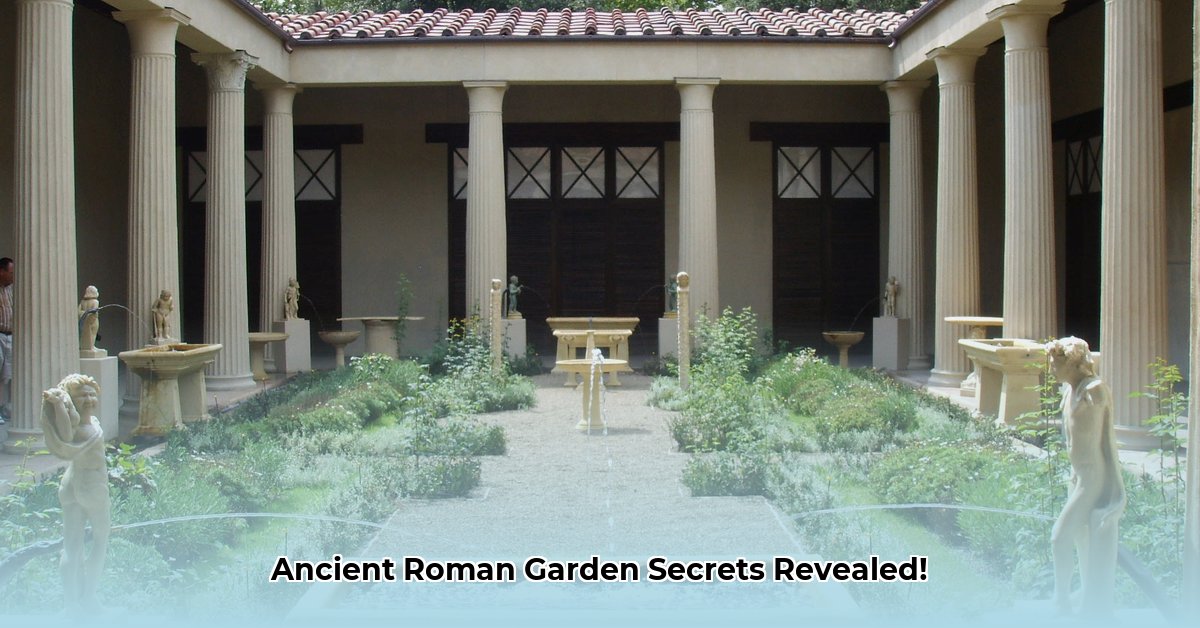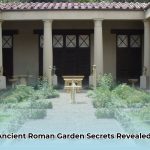Step into the flourishing world of Roman gardens, spaces that transcended mere greenery to become vibrant reflections of Roman culture, power, and daily life. This analysis delves into how these gardens evolved from utilitarian plots into sophisticated landscapes, whose design principles continue to resonate and inspire contemporary horticulture. Learn more about Roman garden design and its key principles.
Beyond their aesthetic appeal, Roman gardens offer profound insights into ancient engineering, social dynamics, and a unique synthesis of practicality and luxury. This exploration uncovers the significant influences from Egyptian, Persian, and Greek horticultural traditions, examines ingenious features such as the xystus and sophisticated water management systems, and identifies key plant species that defined the quintessential Roman garden.
From the compact urban hortus to the sprawling country villa, understanding the diversity and intricate design of Roman gardens provides a timeless blueprint for creating beautiful, functional, and sustainable green spaces in any era.
Key Principles of Roman Garden Design:
- Roman gardens, originally serving as vital food sources, transformed into elaborate displays of wealth, social status, and leisure, embodying a dual emphasis on utility and aesthetic luxury.
- Their design was profoundly shaped by the sophisticated horticultural practices and aesthetic sensibilities of Egyptian, Persian, and Greek cultures, demonstrating remarkable Roman adaptability and integration.
- Central to their beauty and multifaceted utility were integrated architectural elements, including peristyle courtyards, advanced water features such as fountains, pools, and rills, and meticulously sculpted topiary.
The Genesis of Roman Greenery: From Agricultural Roots to Artistic Expression
The earliest Roman gardens were fundamentally practical, serving as essential kitchen gardens (hortus) typically located adjacent to the farmhouse. These provided herbs and vegetables crucial for household sustenance. As noted by Cato the Elder in his treatise De Agri Cultura, emphasis was placed on the garden’s proximity to the house and the inclusion of both practical flowerbeds and ornamental trees. The expansion of Roman influence brought increased contact with diverse cultures, significantly broadening their horticultural scope.
The horticultural traditions of Egypt, Persia, and Greece exerted a profound impact. Formal gardens in Egypt, well-developed by 2800 BCE and perfected by the 18th Dynasty, beautified the homes of the affluent and pioneered porticos connecting indoor and outdoor living spaces. Persian gardens, adapted to arid climates, featured enclosed designs to conserve warmth and moisture, fostering rich, fertile soil in stark contrast to the barren surrounding terrain. It is believed that Romans adopted advanced water management techniques, such as the use of rills – small, open channels for irrigation – from these traditions, likely transmitted through Greek acquaintance, despite limited direct archaeological evidence in classical Greek gardens. Alexander the Great’s conquests introduced new varieties of fruits and plants to the Roman world, further stimulating horticultural interest. This intermingling of influences demonstrates Rome’s pragmatic yet innovative approach to garden design.
Architectural Harmony: Pillars, Ponds, and Pathways in Roman Landscapes
The essence of a Roman garden lay in its immersive design, where every element contributed to a cohesive, experiential space. Each distinct garden style reflected a meticulous integration of natural beauty with architectural precision.
Peristyle Courtyards: Domestic Sanctuaries
The peristylium, an open colonnaded courtyard, emerged as a defining feature of Roman domestic gardens, particularly in urban dwellings like those extensively excavated at Pompeii. This architectural innovation, with its surrounding columns supporting a portico, created a tranquil oasis at the heart of residences. The peristyle seamlessly blended indoor and outdoor living spaces, providing essential light and ventilation while serving as a serene retreat from the bustling city. The design effectively created a protected, inviting environment, epitomizing the Roman desire for domestic harmony.
Water Features: The Vital Arteries of the Garden
Water was an indispensable element in Roman garden design, symbolizing life, luxury, and providing practical utility in a warm climate. Fountains, reflecting pools, and rills were common. Roman engineering prowess, particularly their sophisticated aqueduct systems and mastery of concrete, was crucial in constructing and maintaining these complex water networks. The soothing sounds of flowing water served not only to cool the air but also to mask the urban clamor beyond the garden walls, creating an atmosphere of peace and seclusion. Nymphaea, ornamental grottoes or shrines often incorporating fountains and dedicated to nymphs, added elements of mystical beauty and served as picturesque locations for contemplation or elegant banquets.
Deliberate Structures: Purposeful Pathways and Pavilions
Roman gardens were not merely flat expanses but thoughtfully structured environments designed for diverse activities and specific functions. The xystus, a leveled garden walk or terrace often shaded by strategically planted trees, provided an ideal location for leisurely promenades and philosophical discourse. Often, the xystus would overlook a lower garden, or ambulation, which bordered a vibrant array of flowers, trees, and other foliage, inviting relaxed strolls after meals or during conversations. The gestation offered another defined route for enjoyment, typically a shaded oval-shaped avenue where the master of the house could ride horseback or be carried by servants. Pathways, constructed from loose stone, gravel, sand, or packed earth, facilitated movement through the garden. Ornamental objects, including sculptures, intricate frescoes depicting nature scenes, sundials, and aedicula (small shrines to deities or otherworldly figures), further enhanced the garden’s thematic and aesthetic appeal. Even the atrium, though technically inside the house, was functionally linked to the garden through its impluvium, a central basin designed to collect rainwater for irrigation. Garden walls were more than mere boundaries; they were decorated with statues, paintings, and designs to extend the garden’s theme, and in practical gardens like the shop garden at Pompeii, fragments of pottery embedded into the walls deterred vandalism, as documented by Wilhelmina Jashemski.
An Agricultural Tapestry: The Flora of Ancient Rome
The horticultural palette of the ancient Roman garden featured a rich combination of both indigenous and imported plant species. Common inclusions were stately pine trees, fragrant roses, aromatic cypress, pungent rosemary, productive mulberry trees, and a diverse selection of blooming plants, essential culinary herbs, and vital vegetables. The specific choice of flora was influenced by the garden’s location, size, and intended function. Plants were often arranged by size, with smaller varieties positioned at the front of beds and larger ones at the back.
- Herbs for Sustenance and Healing: Staples such as garlic, basil, coriander, dill, parsley, rosemary, onion, and mustard were cultivated across the Roman Empire, extending even to Britannia. These herbs provided both essential flavors for cuisine and crucial ingredients for medicinal remedies.
- Vines for Shade and Sustenance: Grapes and ivy were frequently trained to grow over garden structures or pergolas, creating welcome areas of cool shade and adding an elegant, naturalistic touch. Country villas (villa rustica) often included specialized equipment for processing grapes into wine, highlighting the dual productive and aesthetic role of vining plants. Other vining plants, including various bean species and flowering vines, were also common.
- Flowers for Adornment and Ritual: A wide array of flowers adorned Roman gardens. Archaeological discoveries at garden sites, particularly through pollen analysis, have identified roses, violets, geraniums, and buttercups. Frescoes frequently depict lilies, irises, daisies, and other popular blooms. Large-scale commercial flower gardens, such as the Garden of Hercules at Pompeii, also existed. Flowers and plants like parsley were cultivated both for their beauty and for use in perfumes, ceremonial garlands, and religious rites. Horace noted that flower gardens became a national indulgence during his time.
- Trees for Shade, Support, and Symbolism: Trees provided crucial shade, structural support for vining plants, and yielded fruit. More elaborate gardens featured formally planned orchards, while simpler gardens integrated trees among other plants. Common varieties included olive, chestnut, cypress, pine, almond, and mulberry trees, alongside imported citrus species. Pliny the Elder, in his Natural History, records that certain trees were planted in honor of various gods, underscoring their symbolic significance. Horticultural techniques such as grafting and cross-pollination were utilized, and by the 1st century CE, hothouses were used for forcing grapes and melons.
From Urban Dwellings to Grand Estates: The Diverse Spaces of Roman Greenery
The character and scale of Roman gardens varied significantly, reflecting the owner’s social standing and the geographical context.
- Urban Gardens (Domus): Confined within city limits, urban homes often featured a hortus or peristylium as a private oasis from the city’s din. These gardens, exemplified by the House of the Surgeon in Pompeii, were typically smaller, maximizing the efficient use of limited space. With the rise of multi-story insulae (apartment buildings), these ground-level gardens gave way to window boxes or roof gardens.
- Villa Gardens: Country villas, serving as retreats from urban life, boasted extensive and diverse gardens.
- Villa Rustica: These large farmhouses were the hubs of agricultural estates. Their gardens were planted on a grand scale and often included processing equipment, indicating their productive capacity. Examples like Villa Boscoreale in Herculaneum reveal technologically advanced gardens with irrigation, grafting, and cross-pollination.
- Villa Urbana and Villa Suburbana: These suburban and urban villas were country homes or holiday excursions for the wealthy. Their gardens were lavishly decorated and could include private gymnasiums and larger open areas for recreation or hunting. Pliny the Younger describes his maritime villa at Laurentum, highlighting its elaborate garden design.
- Imperial Gardens: Reserved exclusively for imperial families, these gardens were the epitome of extravagance. Constructed in diverse locations, palace gardens within cities sometimes shifted prominence with changes in ruling families, while imperial villa gardens, though structured like typical country villas, were far more elaborate, showcasing the empire’s vast wealth and power.
- Non-Residential Gardens: These public spaces included temple gardens, sacred groves (collections of trees dedicated to specific deities), and public parks. Often funded through euergetism — the philanthropy of wealthy citizens — these gardens were accessible to the general populace and frequently attached to public buildings like theaters or baths. Commercial gardens, specializing in the cultivation of produce or flowers for profit, also fell into this category. Augustus, for instance, constructed the Porticus Liviae, a renowned public garden on the Oppian Hill in Rome. In less traditional Greek cities like Sparta, Corinth, and Patras, which adopted Western peristyle domestic gardens, non-residential gardens served to beautify temple groves and create recreational spaces. Cimon of Athens is even said to have transformed his private garden into a public space. Outside Rome, particularly in centers of wealth, redesigned versions of Roman gardens were adopted in settlements across Africa, Gaul, and Britannia.
Enduring Echoes: Ancient Wisdom for Modern Gardens
The profound influence of the ancient Roman garden did not cease with the decline of the Empire. Its principles filtered through the Byzantine Empire, profoundly shaping the aesthetics and practices of early Italian gardens. This legacy, in turn, critically informed the Renaissance, Baroque, Neoclassical, and even 20th-century landscape architecture across Europe and beyond. Contemporary Italian gardens, for example, conspicuously feature interplanting of various species and the timeless use of terracotta pots, directly echoing Roman horticultural practices.
Translating History into Contemporary Landscapes: Actionable Insights
The lasting principles demonstrated by Roman garden design offer valuable lessons for modern landscape architects, preservationists, and gardeners.
| Stakeholders | Short-Term (0-1 Year) | Long-Term (3-5 Years) |
|---|---|---|
| Landscape Architects | Integrate elements such as colonnaded courtyards, structured pathways, and subtle water features into contemporary designs, prioritizing functionality and sustainable resource management akin to Roman engineering. | Develop innovative, drought-resistant planting schemes and advanced water harvesting systems, inspired by Roman garden resilience in arid climates, to address modern climate change challenges. Advocate for legal frameworks that consider shade impacts on neighboring properties, echoing Roman property norms. |
| Historical Preservationists | Utilize multidisciplinary research, including archaeobotanical analysis and detailed study of frescoes and mosaics, to accurately identify and reconstruct the flora and layout of historical Roman gardens. | Create immersive virtual reality (VR) or augmented reality (AR) experiences that authentically reconstruct Roman gardens for public engagement, drawing on comprehensive archaeological and classical literary sources. |
| Home Gardeners | Begin cultivating heritage Roman herbs and vegetables in kitchen gardens, such as dill, coriander, and basic greens, for both culinary use and a connection to ancient practices. | Implement classical Roman horticultural techniques such as the extensive use of terracotta pots for container gardening and interplanting diverse species to naturally enhance soil health and manage pests without synthetic interventions. |
Sustainable Legacies: Roman Wisdom for Environmental Stewardship
The impact of the ancient Roman garden also extended into legal and environmental considerations. Roman legal norms, for example, included provisions for careful tree placement to prevent adverse effects on neighbors, such as blocking essential light or obstructing views. This foresight into community and environmental harmony from such an ancient civilization is remarkable. Modern landscape architects can draw upon this precedent to design sustainable spaces that integrate efficient water management systems and prioritize drought-resistant flora, directly reflecting the Roman emphasis on meticulous resource conservation and harmonious urban planning.
Further Explorations into Rome’s Green Past
To gain a more profound understanding of the intricate world of Roman gardens, consider the following resources:
- Academic and Online Databases: Reputable historical and archaeological websites, such as the comprehensive overview available on Roman Gardens – Wikipedia and detailed research on specific garden types like those found on Archaeology.org, offer invaluable insights.
- Museum Collections and Exhibitions: Numerous museums globally feature artifacts, reconstructions, and detailed exhibits related to Roman domestic life, gardening practices, and horticultural tools.
- Specialized Scholarly Works: Consult dedicated academic and popular publications that offer in-depth analyses of Roman garden history, design principles, and their enduring practical applications for contemporary gardeners.
By delving into the sophisticated principles and dedicated passion behind ancient Roman gardens, one not only obtains valuable historical knowledge but also acquires timeless blueprints for cultivating beautiful, functional, and truly sustainable green spaces in modern life.










